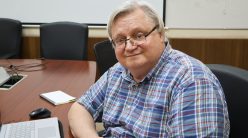People from different cultural and linguistic backgrounds came together and composed artworks in 18 different languages for this display of scripts, part of Spectrum 2018

One monsoon evening last year, I was at the Ranade Library having a casual conversation with a friend. The rain had settled the dust on the Gymkhana ground and, in the distance, the sky behind the World Trade Centre was red. Everything seemed sublime – except but for the old bookshelves in the library. The books were dusty and were not in good condition. I decided to try and improve the situation in the library.
I soon became the convenor of the library. My team then came up with a plan to change things around, and we have worked diligently towards it. In the past few months, though I cannot claim that everything went according to plan, we have made some progress. Our drive started with digitising the book catalogue and making this available online, and we were joined by quite a number of enthusiastic volunteers. It was an immensely boring and time-consuming job to open the books, search for their names (as in many cases the cover pages did not exist), number, name of the author and note all these details in an Excel sheet. Eventually, we had a digital catalogue.
After this work was done, some of us pondered on the next step. Ranade Library is a hub for different cultures from across the country, with more than 8000 books in various languages. We thought this linguistic diversity should be celebrated. So, in one of our meetings, we decided to commemorate International Mother Language Day, which falls on 21 February. It was in another such meeting that the idea of displaying various scripts came up. However, because of a shortage of funds, we were unable to organise it on 21 February as we had planned. But the idea of displaying scripts became a reality when the Gymkhana asked Ranade Library to do something for Spectrum 2018, the annual sports, literary and cultural meet of IISc.
Displaying scripts and preparing their artworks required volunteers and thankfully we were able to find them. People from different cultural and linguistic backgrounds then sat together and composed artworks in their own languages. What’s more, they helped each other – someone from Odisha helped prepare the Tamil exhibit, a Bengali helped with the Gujarati script, someone who knew Urdu wrote in Arabic, a Nepali drew the Tibetan script, and a Malayali made Hebrew calligraphy. It was such a wonderful moment. The results were on display Sarvam Complex from 24 to 28 March 2018.

In the end, we had 18 different scripts and languages from different parts of India and the world: Arabic, Assamese, Bengali, Devanagari, Gujarati, Hebrew, Kannada, Malayalam, Marathi, Odia, Persian, Punjabi, Russian, Sharda, Tamil, Telugu, Tibetan and Urdu. Ideally, we would have liked to have done more. Unfortunately, we did not get much representation from the Sino-Tibetan languages (Tibetan though has been displayed). We could not get a volunteer to display Hindi (although the script is the same as Devanagari, which was displayed for Sanskrit). A display of endangered languages such as Meitei, Naga, Santhali would have made the event more impactful. And the exhibition would have been culturally richer had there been a greater linguistic diversity among the participants. Nevertheless, we are proud of what we have been able to pull off given our constraints. This was the first time that experimental artwork on languages has been displayed at IISc.
What kept us going was our passion and the drive to do our bit to preserve our rich cultural heritage. “India is a land of diversity. When I first read the broadcast email about the scripts display event, I got really excited,” one of the volunteers told me. “I registered and when I attended the first meeting, I was impressed by the vision of showcasing the diversity of our vast land in terms of languages. Such an event had never happened in IISc earlier. I thought it would be a great idea to contribute to the event by bringing in the Gurmukhi (Punjabi) script, which many people might not know about. It was a great learning experience while working together on the designs for all the languages and I am indeed very glad to see that the event has turned out to be so beautiful.”
* Jyotirmoy is a PhD student at the Centre for Earth Sciences, and the convenor of Ranade Library. He would like to thank his team members and the volunteers who helped organise this event.




